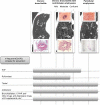COPD: it is time to change!
- PMID: 26648707
- PMCID: PMC4648605
- DOI: 10.2147/COPD.S87696
COPD: it is time to change!
Abstract
COPD is a common cause of disability, morbidity and mortality worldwide and a major global health problem with enormous direct and indirect health care costs. Different reasons can be advanced to explain it, but among them the possibility that the recommended diagnostic and therapeutic approaches to COPD were less effective than they could be, should be also considered. The pharmacological baseline treatment of stable COPD has been widely based on the severity of airflow obstruction and recently, of chronic symptoms and on the annual number of previous exacerbations. These recommendations do not take into account the underlying prevalent disease that should be treated and the future risk. Our suggestion is that the therapy must be firstly tailored on the prevalent disease leading to COPD, independently from the degree of FEV1 reduction and chronic dyspnea and only after that, according to the severity of the disorder (and age of patient), to establish the level of the treatment in order to freeze, when possible, and not to follow the underlying pathological process, running after it. Moreover, given the relevance of exacerbations in the natural history of COPD, greater effort should be placed on recognition of their prevalent type in frequent exacerbators and to prevent them using more tailored and specific treatment.
Keywords: COPD; prevention of COPD exacerbations; therapeutic approach of COPD.
Figures


References
-
- Global Initiative for Chronic Obstructive Pulmonary Disease Global strategy for the Diagnosis, Management and Prevention of Chronic Obstructive Pulmonary Disease. [Accessed December 15, 2014]. (Global Initiative for Chronic Obstructive Pulmonary Disease: 2014). Available from: http//www.goldcopd.org/uploads/users/files/GOLD_Report_2014_Jun11.pdf.
-
- Menn P, Heinrich J, Huber RM, KORA Study Group et al. Direct medical costs of COPD – an excess cost approach based on two population-based studies. Respir Med. 2012;106:540–548. - PubMed
-
- Murray CJL, Phil D, Lopez AD. Measuring the global burden of disease. N Engl J Med. 2013;369:448–457. - PubMed
-
- ERS White Book . The Burden of Lung Disease. Sheffield: ERS White Book; 2013. Chapt 1:1–15 and COPD Chapt 13:1–12.
MeSH terms
Substances
LinkOut - more resources
Full Text Sources
Medical

